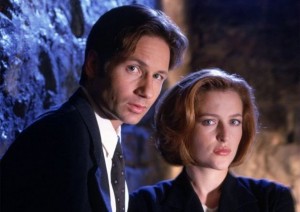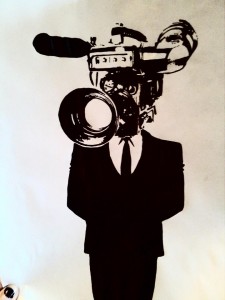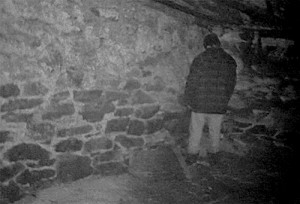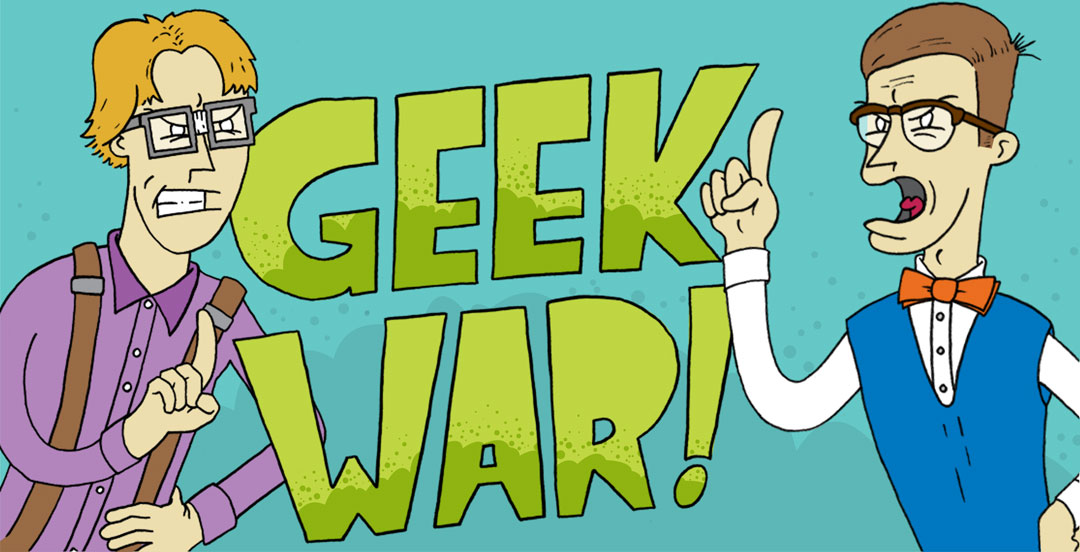Geek War is a semi-regular dueling column between Tim Gaydos and Linton Lewis, where they argue over pop culture with varying degrees of intensity.
For the last decade and a half, the found-footage genre has become one of the most visible forms of horror for the movie-going public. It skyrocketed after its use in the indie film The Blair Witch Project to become a mainstream mainstay in films like the Paranormal Activity series (four films and a spin off and counting), Cloverfield and V/H/S.
Obviously people like it. But there are plenty of critics as well, who see it as a way for lazy filmmakers to churn out cheap thrills with diminishing returns. Is there value in the genre, or are its pitfalls too many?
Tim
I will just say right off the bat that I am a sucker for found-footage movies. If you tell me something is a found-footage movie I will probably watch it, regardless of quality. And I will freely admit that a lot of them are garbage. But the same can be said of most genres, and I think the potential within found-footage movies is unique and fascinating.
Take the poster child for the genre, The Blair Witch Project. It wasn’t the first film to use this gimmick, but it was the one that launched it into the mainstream. It’s also an incredibly successful use of the style. What you don’t see is always scarier than what you do see, and the film smartly keeps any monsters or ghosts off-screen, using the confinements of the two handheld cameras to slowly build a sense of dread. It’s left to the imagination to fill in the blanks on what is making those noises in the dark and leaving mysterious objects. It also allows the movie to focus on the emotional breakdown of the characters, and since the audience doesn’t know or see anything the characters don’t, it helps translate that terror.
Of course the second Blair Witch movie is shit, but they also moved away from the found footage angle. So OBVIOUSLY that’s a point in the genre’s favor, no?
Linton
I agree that found-footage movies have a lot of potential. I have seen a good deal of them (though by no means the majority), and every time I enter one I essentially become Fox Mulder. I want to believe. I want a found-footage movie to convince me, even if for a moment, that this is real. And on top of that I want the film to be good.

Unfortunately, I’m ultimately disappointed on both counts. Usually there are too many ridiculous holes to make me accept the world as presented, and those holes, along with general bland storytelling, leads me to be let down. Of those I’ve seen, both REC and Quarantine were enjoyable, Cloverfield had good parts, Europa Report was too slow but worked better than most, and Blair Witch, the granddaddy of them all, frustrates me in general (more on this later), but I’ll allow that parts work well and it does feel closest to “real” than most others. Of the remaining films I’ve seen, they tend to be pretty forgettable.
Certainly horror is a genre that leads to forgettable products since the films are so cheap to make and there are probably more films of the genre per year than any other. That said, horror has also given us Rosemary’s Baby, The Shining, The Fly, Halloween and The Texas Chainsaw Massacre. Found-footage as a subgenre has produced nothing on par with those films. I want to like found-footage movies, but they’ve got some growing up to do.
Tim
I’m going to assume by “holes” you mean “Why are these assholes still filming?!” which is a really prominent criticism (correct me if my assumption is wrong). This can be really annoying, and works to take you out of the film, and thus torpedo the suspense the movie is trying to create. But filmmakers have begun to get a little more creative in framing their stories so it’s not just another variation of “documentary crews gets into trouble OH NO.”
The V/H/S series, while uneven (as most anthologies are), has been pretty clever with some of their entries. The first segment of the first film starts by the protagonist donning what is essentially Google Glass, which makes it a lot more believable he would leave the camera rolling, since turning off the camera would actually be more effort than leaving it on. The zombie segment in V/H/S/2 works very well for a similar reason, repurposing a GoPro camera as the audience’s eyes and ears. As technology keeps advancing, this problem with the genre will hopefully become less of an issue.

Aside from that, most of the other problems you listed are problems with horror in general. True, found footage has not produced their The Shining yet. But how long did it take for horror to mature to that point? Found footage is still relatively young, and I think it has shown signs of evolving. You mentioned Europa Report, and while it is definitely slow from a narrative standpoint, it was a huge leap forward in terms of the execution and structure. There are a hell of a lot of misses to be sure, but I see signs that the genre as a whole is moving forward.
Linton
Sometimes it’s “Why are these assholes still filming” but other times it’s “Why are these assholes filming in the first place?” The Google Glass and GoPro examples you mentioned are good workarounds, but they can’t be the only ones going forward. More will need to be done to make the genre more plausible and less clunky.
As for your point about horror needing to progress to the point of The Shining, you lost me a little. It’s not as though The Shining (or any other masterpiece) stopped existing when found-footage emerged. The people who make found-footage films have a century’s worth of horror to learn and draw from. Even though this is a subgenre it doesn’t mean the lessons that have come before should be ignored.
In fact, if you look at the very early days of horror you’ll see a lot of classic films that still work on their own merits: The Cabinet of Dr. Caligari, Nosferatu, The Phantom of the Opera, Faust and M just to name a few. If guys in the ‘20s can figure out how to make great horror films when people barely knew how to make films, then found-footage has no excuse.
What I think is really lacking, though, are great writers and directors tackling the genre. Romero tried one with Diary of the Dead and that certainly wasn’t great, but there are so many other directors that could put a unique and intelligent spin on this subgenre. I want a Park Chan-wook found-footage film. I want a David Cronenberg found-footage film. But then again, maybe the big boys will continue to avoid the genre while it continues to coast by on simplicity.
Tim
I think that the big obstacle preventing the big boys from dipping their toes in the water of found-footage is that, admittedly, found-footage movies don’t really look good.
By their nature there isn’t much of a place for shot composition, and the believability of the characters lugging around a camera really breaks down if they were to use high-end film cameras to get that nice, clean look. And this is really a shame, because I think there is so much that could be done within the confines of the genre in the right hands. A Park Chan-wook found-footage movie would be amazing. But it will likely never happen, because there is a perception of cheapness and simplicity. I can’t argue with that. All I want is for people to look beyond those aspects to see what does truly work within the genre.
Paranormal Activity 3, while overall a so-so movie, has one of my favorite moments tucked away within it. The stepfather, wanting to capture the unexplained activities on camera (because that is ALWAYS their first thought), removes the top of a rotating fan and sticks his camera on it. As its left there, moving back and forth, panning at a steady pace regardless of where the action might be taking place, it is superbly effective at creating tension. True, this kind of shot can be done in films that aren’t found-footage. The Orphanage employs a similar shot towards its end. But there’s something about it being used in the found-footage setting that gives it more weight. It makes internal sense that the camera, and our view and perception, would move like that. It’s organic, and because found-footage movies are nominally “real,” it keeps you on the edge of your seat just a little bit more. If that’s what the dude who did Catfish can come up with, just imagine what a Wes Craven in his prime could accomplish.
That is what the genre really needs. I’m with you that most found-footage movies need much better writing, because even if the format provides for suspense, the actual stories tend to be a weak point. There are some exceptions. While I know you’re not a huge fan, I genuinely enjoyed Cloverfield all around. The Last Exorcism came really close to transcending the genre, as for most of the movie it seemed to deconstruct itself. But then they ruined it in the last ten minutes. Even The Blair Witch Project, which I still hold up as the standard bearer, wasn’t “written” so much as it was compiled by filmmakers saying “We’re gonna send some kids in the woods and fuck with them for a couple days.” It is effective though.
Ultimately though, I just find the idea of found footage fun. That’s not objective, to be sure, and even though there is a lot of crap I’ll willingly sit through it for the stuff that works. I’ll keep watching as they take their baby steps, and rejoice when all the pieces finally come together to form a masterpiece.
Linton
I’m glad you brought up Blair Witch because I just watched it for the first time in fifteen years. When it came out in ’99 I was sixteen and very susceptible to getting caught up in the hype that was being built around it. Upon seeing it, I was quite disappointed, though, mostly because there were only three “scary” parts as I saw it: the bag of teeth, the dreamcatcher forest, and Mike in the corner. So I felt cheated.

I can say that revisiting the movie both reinforced and challenged my critique. The atmosphere the filmmakers created is effective and impressive, as you say, and the cast does a solid job making their characters feel very human, and much more so than most actors in this genre. But the three scenes I mentioned are still the only really unsettling parts, and while the characters do get a decent amount of development, I could have done without the second act being essentially a forty minute argument. The worst aspect, however, is that the movie doesn’t make much sense, even when giving the filmmakers the benefit of the doubt in that the audience has all the info the characters have.
In the movie we’re told there’s possibly some witch in the woods, and there’s also a child murderer who spent time in the region. We get the (interesting) detail that he would make his victims stand in the corner until he was ready to kill them. So when it comes time for the ending, and Mike is in the corner, the audience is meant to go “What the fuck!” and get scared out of their minds. But how does this add up? Is the murderer still alive? Is he a ghost? At times you hear children giggling outside the tent and see their handprints on walls – so are the dead children this guy killed just hanging out with him as ghosts? How does the “witch” figure into this? I realize there’s a benefit to creating mystery in horror, but you need to have payoff. That ending may be creepy, but it doesn’t act as catharsis because there’s no real story preceding it.
So while The Blair Witch Project may work a lot better than many films of its type, it still falls victim to favoring flash and style over substance. Give me Rosemary Woodhouse screaming “What have you done to its eyes?!” or Jack Torrance’s urge to kill fading along with his pulse. Make me care and you’ll be one step closer to making me believe.

